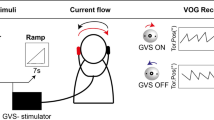Abstract
The vestibulo-ocular reflex (VOR) produces compensatory eye movements by utilizing head rotational velocity signals from the semicircular canals to control contractions of the extraocular muscles. In mammals, the time course of horizontal VOR is longer than that of the canal signals driving it, revealing the presence of a central integrator known as velocity storage. Although the neurons mediating VOR have been described neurophysiologically, their properties, and the mechanism of velocity storage itself, remain unexplained. Recent models of integration in VOR are based on systems of linear elements, interconnected in arbitrary ways. The present study extends this work by modeling horizontal VOR as a learning network composed of nonlinear model neurons. Network architectures are based on the VOR arc (canal afferents, vestibular nucleus (VN) neurons and extraocular motoneurons) and have both forward and lateral connections. The networks learn to produce velocity storage integration by forming lateral (commissural) inhibitory feedback loops between VN neurons. These loops overlap and interact in a complex way, forming both fast and slow VN pathways. The networks exhibit some of the nonlinear properties of the actual VOR, such as dependency of decay rate and phase lag upon input magnitude, and skewing of the response to higher magnitude sinusoidal inputs. Model VN neurons resemble their real counterparts. Both have increased time constant and gain, and decreased spontaneous rate as compared to canal afferents. Also, both model and real VN neurons exhibit rectification and skew. The results suggest that lateral inhibitory interactions produce velocity storage and also determine the properties of neurons mediating VOR. The neural network models demonstrate how commissural inhibition may be organized along the VOR pathway.
Similar content being viewed by others
References
Anastasio TJ, Robinson DA (1989a) The distributed representation of vestibulo-oculomotor signals by brain-stem neurons. Biol Cybern 61:79–88
Anastasio TJ, Robinson DA (1989b) Distributed parallel processing in the vestibule-oculomotor system. Neural Comp 1:230–241
Anastasio TJ, Robinson DA (1990) Distributed parallel processing in the vertical vestibulo-ocular reflex: Learning networks compared to tensor theory. Biol Cybern 63:161–167
Blair SM, Gavin M (1981) Brainstem commissures and control of time constant of vestibular nystagmus. Acta Otolaryngol 91:1–8
Buettner U, Waespe W (1981) Vestibular nerve activity in the alert monkey during vestibular and optokinetic nystagmus. Exp Brain Res 41:310–315
Buettner UW, Buettner U, Henn V (1978) Transfer characteristics of neurons in vestibular nuclei of the alert monkey. J Neurophysiol 41:1614–1628
Buettner UW, Henn V, Young LR (1981) Frequency response of the vestibulo-ocular reflex (VOR) in the monkey. Aviat Space Environ Med 52:73–77
Cannon SC, Robinson DA, Shamma S (1983) A proposed neural network for the integrator of the oculomotor system. Biol Cybern 49:127–136
Fernandez C, Goldberg JM (1971) Physiology of peripheral neurons innervating semicircular canals of the squirrel monkey. II Response to sinusoidal stimulation and dynamics of peripheral vestibular system. J Neurophysiol 34:661–675
Fetter M, Zee DS (1988) Recovery from unilateral labyrinthectomy in rhesus monkey. J Neurophysiol 59:370–393
Fuchs AF, Kimm J (1975) Unit activity in vestibular nucleus of the alert monkey during horizontal angular acceleration and eye movement. J Neurophysiol 38:1140–1161
Galiana HL, Outerbridge JS (1984) A bilateral model for central neural pathways in vestibuloocular reflex. J Neurophysiol 51:210–241
Hebb DO (1972) Textbook of psychology. Saunders, Philadelphia
Lisberger SG (1988) The neural basis for learning of simple motor skills. Science 242:728–735
McCrea RA, Strassman A, May E, Highstein SM (1987) Anatomical and physiological characteristics of vestibular neurons mediating the horizontal vestibulo-ocular reflex of the squirrel monkey. J Comp Neurol 264:547–570
Milsum JH (1966) Biological control systems analysis. McGraw-Hill, New York
Paige GD (1983) Vestibuloocular of reflex and its interaction with visual following mechanisms in the squirrel monkey. I. Response characteristics in normal animals. J Neurophysiol 49:134–151
Raphan Th, Matsuo V, Cohen B (1979) Velocity storage in the vestibulo-ocular reflex arc (VOR). Exp Brain Res 35:229–248
Robinson DA (1975) Oculomotor control signals. In: Lennerstrand G, Bach-y-Rita P (eds) Basic mechanisms of ocular motility and their clinical implications. Pergamon Press, Oxford, pp 337–374
Robinson DA (1981) The use of control systems analysis in the neurophysiology of eye movements. Ann Rev Neurosci 4:463–503
Rumelhart DE, Hinton GE, Williams RJ (1986) Learning internal representations by error propagation. In: Rumelhart DE, McCleland JL, PDP Research Group (eds) Parallel distributed processing: explorations in the microstructure of cognition, vol 1: Foundations, MIT Press, Cambridge, pp 318–362
Skavenski AA, Robinson DA (1973) Role of abducens neurons in vestibuloocular reflex. J Neurophysiol 36:724–738
Waespe W, Henn V (1979) The velocity response of vestibular nucleus neurons during vestibular, visual, and combined angular acceleration. Exp Brain Res 37:337–347
Williams RJ, Zipser D (1989) A learning algorithm for continually running fully recurrent neural networks. Neural Comp 1:270–280
Wilson VJ, Melvill Jones G (1979) Mammalian vestibular physiology. Plenum Press, New York
Author information
Authors and Affiliations
Rights and permissions
About this article
Cite this article
Anastasio, T.J. Neural network models of velocity storage in the horizontal vestibulo-ocular reflex. Biol. Cybern. 64, 187–196 (1991). https://doi.org/10.1007/BF00201979
Received:
Accepted:
Issue Date:
DOI: https://doi.org/10.1007/BF00201979




